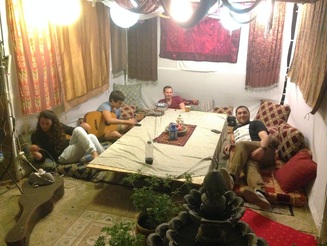
Z’man Simchateinu. A time for rejoicing. If you think Tsfat is lively in the summer during Klezer, try visiting during Sukkot. There aren’t the ebbing crowds of visitors in August, yet there is a true feel of celebration.
During the holiday, you can always find a nice viewpoint (like the roof of Villa Tiferet) and play the game of spotting how many sukkahs you can see in this mountainside town. They perch on rooftops, cling to apartment balconies and nestle in courtyards.
Ooh and Ahh
Guests climb up the stairs to the large rooftop of Villa Tiferet. They ‘ooh and ahh’ over the view, then often say, “What a perfect place for a Sukkah.” We nod yes and no. Although the roof is large and airy, it can be windy at times and it’s a few steps too far from the kitchen for this cook’s liking.
We have designed two sukkahs for Villa Tiferet. We have one in the centre of the main courtyard that seats 10 under the schach. And we have a second neighboring Sukkah above the cozy Morrocan pillows. This is our sleeping Sukkah, our napping Sukkah and the Sukkah for an overflow of guests.
Our sukkah is literally three steps from the action of the kitchen so serving food and clearing dishes is a breeze. We can gaze at the stars twinkling in that black velvet Tsfat sky and often sing zmirot along with our neighbours who belt out their favorite Sefardi tunes from their sukkah.
If you go for a walk in the evening, you’ll hear song and laughter coming from multiple sukkahs in the Old City and the Artists’ Quarter. You can see shadows of guests lifting a glass, children playing at the table and often catch snippets of a dvar Torah.
Early morning, people head off to shul carrying their lulav and etrog like prized jewels. The synagogues are packed with festive shul goers who wave their lulavs with utmost intensity.
During chol hamoed, there are several musical hallels throughout town. Check out the House of Love and Prayer and the Beirav. If you play an instrument that is portable, bring it along and join in. We have danced and twirled accompanied by violins, guitars, drums, accordions and flutes. Hallel in Tsfat is beyond uplifting and may even take you through till lunch!
Being in Tsfat over Sukkot also enables you to enjoy the best of the north. The weather is breezy and can be refrshingly slightly cool, so hiking is a great choice. There is Nahal Amud just below the old Tsfat cemetery. If you have a car, head to Yehudiah in the Golan or to Montfort in the northwest. There is also horseback riding nearby, jeep tours and the refreshing Kinneret.
Chag HaAsif
One of the themes of Sukkot is agriculture. Chag Ha’Asif means holiday of gathering. Autumn in the north is the time to gather the grapes. If you decide to visit one of the local wineries, you may be able to see the grapes being crushed, their sweet juice then separated from the seeds to create a new vintage.
It’s also time to collect olives. You will see people laying down blankets on the ground and bashing the trees, causing the olives to fall. This is a family event where children and grandparents join in the harvest.
A Time of Bounty
Sukkot is a time of bounty, rejoicing and of appreciating family, friends and the beauty of the abundance we have in Israel. And there is no better place to experience this than in Safed.
During the holiday, you can always find a nice viewpoint (like the roof of Villa Tiferet) and play the game of spotting how many sukkahs you can see in this mountainside town. They perch on rooftops, cling to apartment balconies and nestle in courtyards.
Ooh and Ahh
Guests climb up the stairs to the large rooftop of Villa Tiferet. They ‘ooh and ahh’ over the view, then often say, “What a perfect place for a Sukkah.” We nod yes and no. Although the roof is large and airy, it can be windy at times and it’s a few steps too far from the kitchen for this cook’s liking.
We have designed two sukkahs for Villa Tiferet. We have one in the centre of the main courtyard that seats 10 under the schach. And we have a second neighboring Sukkah above the cozy Morrocan pillows. This is our sleeping Sukkah, our napping Sukkah and the Sukkah for an overflow of guests.
Our sukkah is literally three steps from the action of the kitchen so serving food and clearing dishes is a breeze. We can gaze at the stars twinkling in that black velvet Tsfat sky and often sing zmirot along with our neighbours who belt out their favorite Sefardi tunes from their sukkah.
If you go for a walk in the evening, you’ll hear song and laughter coming from multiple sukkahs in the Old City and the Artists’ Quarter. You can see shadows of guests lifting a glass, children playing at the table and often catch snippets of a dvar Torah.
Early morning, people head off to shul carrying their lulav and etrog like prized jewels. The synagogues are packed with festive shul goers who wave their lulavs with utmost intensity.
During chol hamoed, there are several musical hallels throughout town. Check out the House of Love and Prayer and the Beirav. If you play an instrument that is portable, bring it along and join in. We have danced and twirled accompanied by violins, guitars, drums, accordions and flutes. Hallel in Tsfat is beyond uplifting and may even take you through till lunch!
Being in Tsfat over Sukkot also enables you to enjoy the best of the north. The weather is breezy and can be refrshingly slightly cool, so hiking is a great choice. There is Nahal Amud just below the old Tsfat cemetery. If you have a car, head to Yehudiah in the Golan or to Montfort in the northwest. There is also horseback riding nearby, jeep tours and the refreshing Kinneret.
Chag HaAsif
One of the themes of Sukkot is agriculture. Chag Ha’Asif means holiday of gathering. Autumn in the north is the time to gather the grapes. If you decide to visit one of the local wineries, you may be able to see the grapes being crushed, their sweet juice then separated from the seeds to create a new vintage.
It’s also time to collect olives. You will see people laying down blankets on the ground and bashing the trees, causing the olives to fall. This is a family event where children and grandparents join in the harvest.
A Time of Bounty
Sukkot is a time of bounty, rejoicing and of appreciating family, friends and the beauty of the abundance we have in Israel. And there is no better place to experience this than in Safed.

 RSS Feed
RSS Feed


